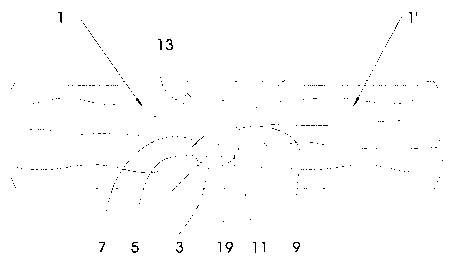Some of the information on this Web page has been provided by external sources. The Government of Canada is not responsible for the accuracy, reliability or currency of the information supplied by external sources. Users wishing to rely upon this information should consult directly with the source of the information. Content provided by external sources is not subject to official languages, privacy and accessibility requirements.
Any discrepancies in the text and image of the Claims and Abstract are due to differing posting times. Text of the Claims and Abstract are posted:
| (12) Patent Application: | (11) CA 2425064 |
|---|---|
| (54) English Title: | GROOVED LATHS AND SELF-CATCHING TABS FOR FORMING FLOORS AND METHOD FOR MACHINING SAID LATHS |
| (54) French Title: | LATTES RAINUREES ET LANGUETTES AUTO-ACCROCHABLES DESTINEES NOTAMMENT A FORMER DES PLANCHERS ET PROCEDE D'USINAGE DE TELLES LATTES |
| Status: | Deemed Abandoned and Beyond the Period of Reinstatement - Pending Response to Notice of Disregarded Communication |
| (51) International Patent Classification (IPC): |
|
|---|---|
| (72) Inventors : |
|
| (73) Owners : |
|
| (71) Applicants : |
|
| (74) Agent: | LAVERY, DE BILLY, LLP |
| (74) Associate agent: | |
| (45) Issued: | |
| (86) PCT Filing Date: | 2000-10-10 |
| (87) Open to Public Inspection: | 2002-04-18 |
| Availability of licence: | N/A |
| Dedicated to the Public: | N/A |
| (25) Language of filing: | English |
| Patent Cooperation Treaty (PCT): | Yes |
|---|---|
| (86) PCT Filing Number: | PCT/BE2000/000121 |
| (87) International Publication Number: | WO 2002031291 |
| (85) National Entry: | 2003-04-07 |
| (30) Application Priority Data: | None |
|---|
The invention concerns laths (1, 1') with grooved longitudinal edges capable
of being interlocked to form a floor. The invention is characterised in that
the laths comprise on their right a groove (3) arranged substantially
perpendicular to the surface of the lath, comprising an indentation (5) on the
side of the groove opposite to the lateral edge of the lath and parallel
bevels (7, 9) oriented towards said lath edge and arranged more or less at 45
degrees relative to the sides of the groove, which co-operate when installed
with a protuberance (19) of the left of the lath, matching in shape said
groove (3), enabling through the bevels (7, 9) the protuberance (19) to be
inserted at an angle of about 45 degrees into the groove (3) and enabling by
simple pressure to interlock two successive laths.
La présente invention se rapporte à des lattes (1, 1') à bords longitudinaux rainurés pouvant s'emboîter en vue de former un plancher, caractérisées en ce que les lattes comportent sur leur profil droit une rainure (3) pratiquée essentiellement perpendiculairement à la face de la latte, comportant un décrochement (5) sur le côté de la rainure opposé au bord lateral de la latte et des chafreins parallèles (7, 9) dirigés vers ce bord de la latte et disposés approximativement à 45 degrés par rapport aux côtés de la rainure, qui collaborent lors de la pose avec un bossage (19) du profil gauche de la latte, de forme complémentaire à ladite rainure (3), en permettant grâce aux chanfreins (7, 9) l'introduction du bossage (19) sous un angle d'approximativement 45 degrés dans la rainure (3) et permettant par une simple pression d'encliqueter deux lattes successives.
Note: Claims are shown in the official language in which they were submitted.
Note: Descriptions are shown in the official language in which they were submitted.

2024-08-01:As part of the Next Generation Patents (NGP) transition, the Canadian Patents Database (CPD) now contains a more detailed Event History, which replicates the Event Log of our new back-office solution.
Please note that "Inactive:" events refers to events no longer in use in our new back-office solution.
For a clearer understanding of the status of the application/patent presented on this page, the site Disclaimer , as well as the definitions for Patent , Event History , Maintenance Fee and Payment History should be consulted.
| Description | Date |
|---|---|
| Application Not Reinstated by Deadline | 2006-10-10 |
| Time Limit for Reversal Expired | 2006-10-10 |
| Inactive: Abandon-RFE+Late fee unpaid-Correspondence sent | 2005-10-11 |
| Deemed Abandoned - Failure to Respond to Maintenance Fee Notice | 2005-10-11 |
| Letter Sent | 2003-09-17 |
| Inactive: Cover page published | 2003-09-12 |
| Inactive: Notice - National entry - No RFE | 2003-09-10 |
| Application Received - PCT | 2003-05-09 |
| Inactive: Single transfer | 2003-05-02 |
| National Entry Requirements Determined Compliant | 2003-04-07 |
| Application Published (Open to Public Inspection) | 2002-04-18 |
| Abandonment Date | Reason | Reinstatement Date |
|---|---|---|
| 2005-10-11 |
The last payment was received on 2004-09-21
Note : If the full payment has not been received on or before the date indicated, a further fee may be required which may be one of the following
Please refer to the CIPO Patent Fees web page to see all current fee amounts.
| Fee Type | Anniversary Year | Due Date | Paid Date |
|---|---|---|---|
| Basic national fee - standard | 2003-04-07 | ||
| MF (application, 2nd anniv.) - standard | 02 | 2002-10-10 | 2003-04-07 |
| Registration of a document | 2003-05-02 | ||
| MF (application, 3rd anniv.) - standard | 03 | 2003-10-10 | 2003-10-03 |
| MF (application, 4th anniv.) - standard | 04 | 2004-10-12 | 2004-09-21 |
Note: Records showing the ownership history in alphabetical order.
| Current Owners on Record |
|---|
| TARKETT SOMMER S.A. |
| Past Owners on Record |
|---|
| GERARD PFEIFFER |
| JEAN-PHILIPPE GEORGES |